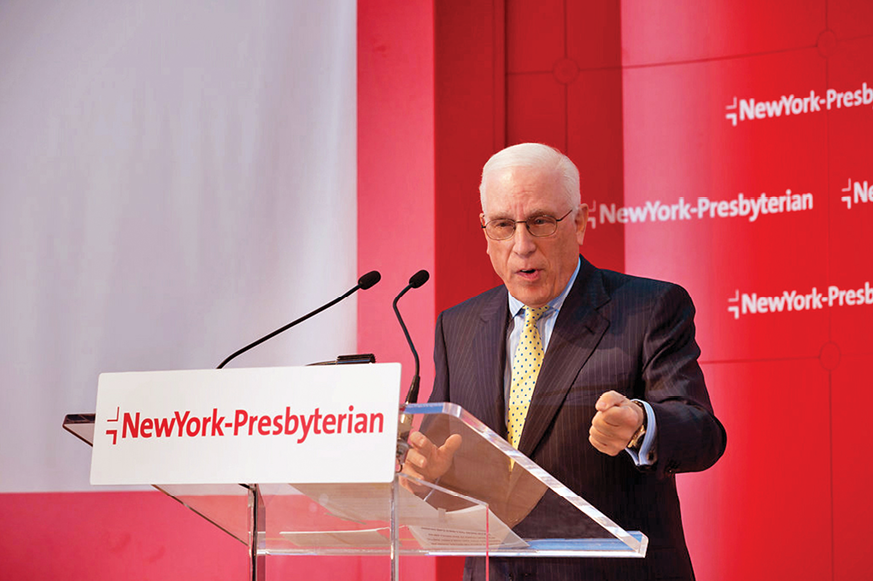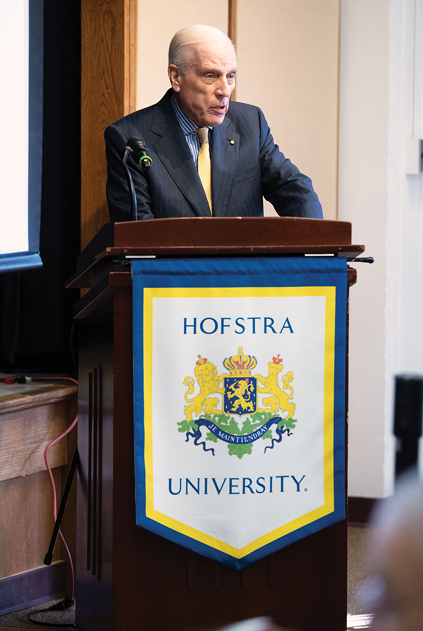- Home
- Media Kit
- Current Issue
- Past Issues
- Ad Specs-Submission
- Ad Print Settings
- Reprints (PDF)
- Photo Specifications (PDF)
- Contact Us

![]()
ONLINE

Builder and Philanthropist
Editors’ Note
Peter Kalikow is the former Chairman of the Metropolitan Transportation Authority (MTA), former Commissioner of the Port Authority of New York & New Jersey, past owner and publisher of the New York Post, and current Chairman of the Grand Central Partnership. Kalikow began his career in real estate in 1967 and became President of HJ Kalikow & Co. in 1973. Following his father’s death in 1982, he assumed responsibility for the Kalikow holdings and is the third generation to preside over the family’s 92-year-old real estate company. Kalikow is an active participant in every major real estate association and serves as a Governor of the Real Estate Board of New York. In recognition of his leadership, he has received the Harry Helmsley Award, the Award for Excellence by the Building Owners and Managers Association of Greater New York for the development of 101 Park Avenue, and the Golden Circle Award. Kalikow is involved in many philanthropic causes. He is a Vice Chair of NewYork-Presbyterian Hospital and a member of its executive committee. Kalikow is a member of the board of trustees of Hofstra University and was awarded an honorary Doctorate of Law degree in 1986. He received Hofstra’s Alumni of the Year Award in 1988. An active student of the American Presidency, Kalikow endowed the Peter S. Kalikow Chair in Presidential Studies and created the Peter S. Kalikow Center for the Study of the American Presidency. In 2015, he endowed the Peter S. Kalikow School of Government, Public Policy & International Affairs at Hofstra University. Kalikow is a founding board member of the Museum of Jewish Heritage and was presented with the Peace Medal, Israel’s highest civilian award for his many years in aiding the nation’s development, including his efforts related to Israel Bonds. He is a founding board member of the National WWII Museum in New Orleans. In November 2008, Kalikow was honored with the Commendatore in the Order of Merit of the Italian Republic, one of the highest honors bestowed by the Government of Italy.
Company Brief
For more than 100 years, HJ Kalikow & Co. (hjkalikow.com) has been one of New York City’s leading real estate firms. Under Peter Kalikow’s leadership, the company has developed millions of square feet of commercial office space as well as constructed many prominent residential apartment houses in Manhattan.

Peter Kalikow speaks at NewYork-Presbyterian Hospital
where he serves as a longtime Trustee
and a Vice Chair of the Hospital
Will you discuss your start in real estate?
I had the advantage of watching and learning from my grandfather, Joe Kalikow, who together with my dad and his two brothers, built thousands of apartment units in Brooklyn and Queens. It was in no way a formal tutorial, but I was able to learn the fundamentals of real estate development by watching their buildings go from the ground up. The most important thing I learned was showing up at job sites each and every day. It sounds simple, but showing up accomplished two things. First, it showed the men working in the various trades that you were committed to finishing the job on time and on budget. Next, it gave me a better sense of what a difference a good relationship between a developer and trades means to a successful job.
I took these lessons and applied them to my first apartment building in Great Neck. It was a great success. Then, I turned my focus on Manhattan, and incorporated my knowledge of consumer preferences into development success. During that time, the 1970s, I had a good sense of what people my age wanted. Their priority wasn’t so much the size of the apartment, but rather safety and security, so I provided reasonably-sized apartment units and 24-hour doorman security. The first apartment was a 24-story apartment building that rented in five weeks. Between 1970 and 1980, I built 10 apartment houses and they were all tremendous successes.
What has made 101 Park Avenue remain relevant and such a sought-after building?
First, its architecture really is timeless and has won a number of awards. The way the building sits on the lot allows for a great amount of light, air and views for the tenants within. Next, my company has always invested a great deal of money to constantly upgrade all of the building systems to ensure the utmost in efficiency for our tenants. In addition, the staff at 101 Park Avenue is first class all the way. Tenants rave about the professionalism and courtesy of the starters at the elevator banks. The engineers work tirelessly to maintain the building systems in top-notch working order. Also, Club 101 and the parking garage are two tremendous building amenities.
The fact is that over 60 percent of the tenants at 101 Park Avenue are original to the building. That statement alone says it all.
Did you know when you built 101 Park Avenue that this part of New York City would become what it is today?
My grandmother came to the United States when she was very young. Whenever my grandfather would start to build a building, he would take her to the site and the first question she asked was, “Where’s the subway?” As wealthy as she was, she always took the subway.
And that has always been a guiding principle of my approach to building. I knew the importance of Grand Central Terminal as a major regional transit hub, and how the Grand Central business district would attract prospective tenants.

Kalikow School of Government, Public Policy and
Internal Affairs,
which Peter Kalikow established
at Hofstra University
You serve as a Vice Chair of NewYork-Presbyterian and have been a part of that institution for many years. What makes NewYork-Presbyterian so special for you?
My father had two strokes and that is where he was treated. My mother had some issues and they took care of her. My children were born there. They treated my family so well. I knew that once I had the means, there was nothing better than getting involved with a hospital. So that is what I did, helping them with the Starr Building, then becoming a board member, then chairman of real estate, then executive committee member, and now a vice chair. NewYork-Presbyterian is consistently ranked as one of the highest in the nation over a wide number of specialties. But it is the focus on the patient first and foremost that makes it the tremendous success that it is. Our Chair, Jerry Speyer, the Board of Trustees, its President and CEO, Steve Corwin, and the entire staff are totally committed to providing the best healthcare in a patient-centric manner.
I tell people that whatever I have given NewYork-Presbyterian in terms of time and money, I have gotten back ten times in terms of satisfaction. It is a terrific institution with wonderful and caring people.
Will you discuss your involvement and support of Hofstra University?
I was lucky to be accepted to Hofstra and lucky to graduate. They gave me an education and I learned a lot, even though I was a terrible student back then. I was a student there in 1964 when the presidential debates started coming to colleges and I imagined back then what it would be like to have a presidential debate at Hofstra.
Decades later, I am so proud to have contributed to the growth and success of the school. I was able to endow a School of Government, Public Policy and International Affairs for students who want to pursue careers in government or other areas that focus on public policy. Hofstra’s reputation in this area has enabled it to host three presidential debates. Most schools would be thrilled to host one.
For over seven years, you were the Chairman of the Metropolitan Transportation Authority, one of the most important state agencies that is responsible for transporting millions of people daily in this region. What do you think about what is happening today with the MTA?
Those were a very exciting seven years, and I think we did a lot of good things during those years. It’s a very hard job, but very fulfilling as well. Looking back, I think one of the most significant things we did during my tenure was to begin to deal with those unsustainable labor costs that are being discussed today. Labor costs consume 60 percent of the operational expenses at the MTA and a good deal of that are costs related to healthcare and pensions. We began to tackle these costs, but clearly more needs to be done. At the end of the day, New York State taxpayers and the system’s fare payers deserve no less.

Peter Kalikow reviewing plans with his architects
for work at 101 Park Avenue
How did your interest in Ferraris develop?
I went to a car show when I was young and I saw this Ferrari. It was like nothing I had seen before. I was mesmerized by it. I went home by subway because we lived in Queens back then and, at dinner, I told my father that he had to come to the car show and see this car. He told me he was too busy but my mother – God bless her, I miss her still – said, “Harold, spend three hours with your son.” We went and I got to sit in this amazing car.
My father says to the guy, “How much is this car?” He said, “$13,000.” He lied. It was actually $15,000. My father responds, “$13,000? It should be $3,000 because I have a Cadillac which is $6,000 and it has four seats. This car only has two seats.”
It took me a long time to get my first Ferrari but, thanks to my parents, I managed to work it out. I have to say, whenever I approach a Ferrari, I still get the rush I got when I saw that first one at the car show. I’m going to Italy soon to spec out my next Ferrari and I have to tell you, the passion never gets old.
Many of your people have been with you for decades. How important has it been to retain talent?
Very important. A person came back to see me about three or four years ago and said, “I’ve been walking down the hallway for 20 years and I notice all the same faces are here.” My people have known me a long time. I’m 76 years old. I was the youngest person here when I started this company and now I am the oldest. People are what makes a business. Great people make great buildings.
Do you think about your legacy and will it be more about your business success or your philanthropic work?
I tell you, I really hope it will be about both. I continue to thoroughly enjoy business – it keeps me focused and engaged. And it is the business that has given me the good fortune to give back to the philanthropic endeavors.![]()